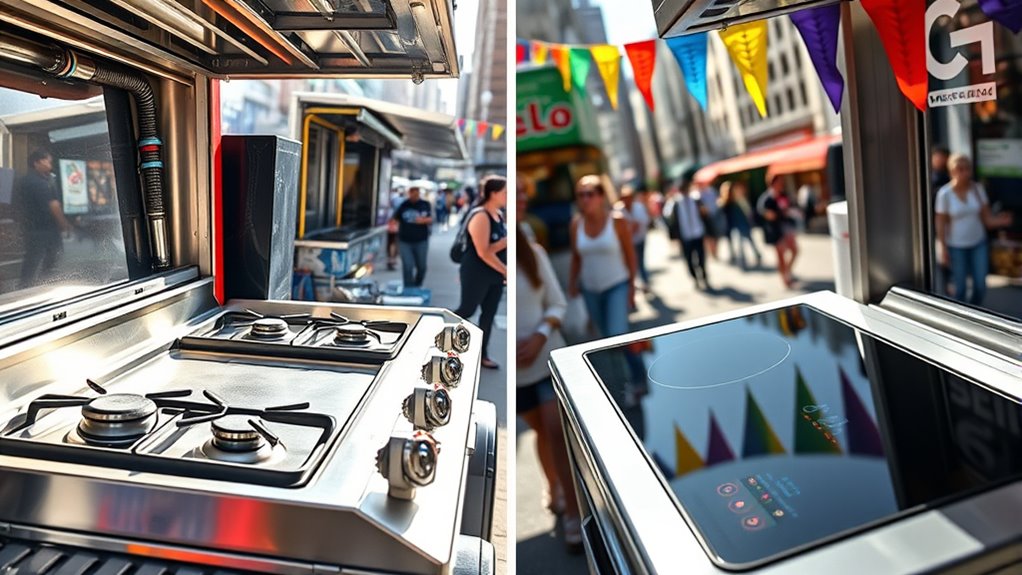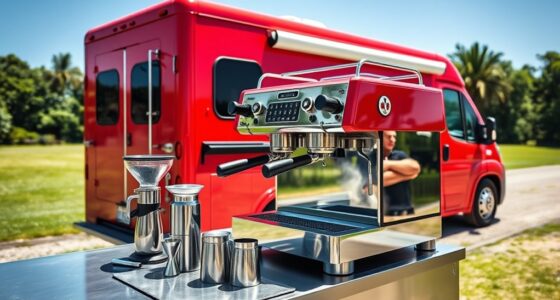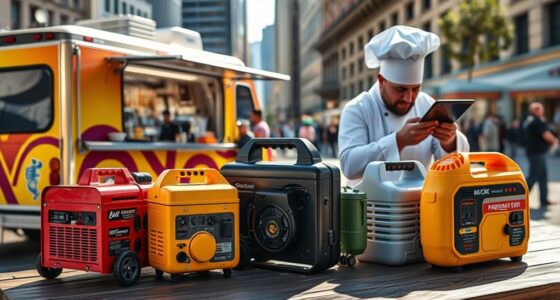Choosing between gas and electric appliances for your food truck depends on your budget, space, and menu needs. Gas units are cheaper upfront and offer faster, high-heat performance ideal for quick cooking, but they require ventilation and safety checks. Electric appliances tend to be more energy-efficient, easier to install, and better suited for limited space, though they may have higher initial costs. To make the best decision for your business, explore the details ahead.
Key Takeaways
- Gas appliances typically have lower initial costs but higher ongoing fuel and maintenance expenses.
- Electric appliances are more energy-efficient, offer precise temperature control, and support environmental sustainability.
- Gas units provide faster heating and higher power output, ideal for quick cooking needs.
- Electric systems require less space and ventilation, simplifying installation and safety compliance.
- The choice depends on budget, space availability, performance needs, and long-term operational costs.
Cost Analysis of Gas and Electric Appliances
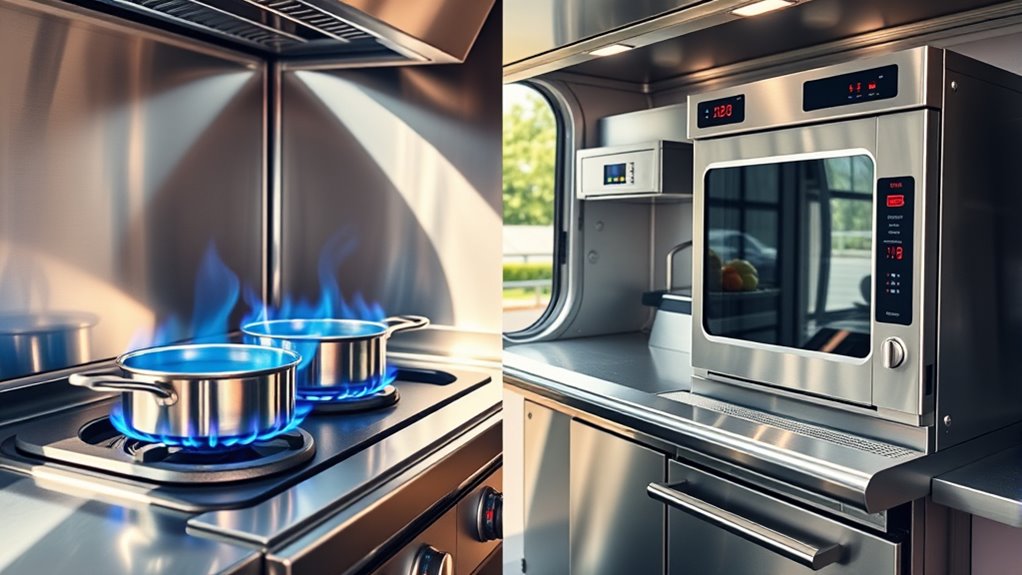
When comparing the costs of gas and electric appliances for food trucks, it’s important to contemplate both upfront and ongoing expenses. Fuel types greatly influence your initial investment—gas appliances often cost less initially but may have higher operating costs over time. Electric appliances tend to have higher upfront prices, yet their lower fuel costs can balance that out in the long run. Additionally, consider appliance lifespan; gas equipment usually lasts longer due to simpler components, which could reduce replacement costs. Electric appliances might have shorter lifespans but can be more energy-efficient. Properly maintaining your appliances, such as checking for wear on components like drivetrain, can extend their lifespan and improve efficiency, further influencing overall costs. Regular maintenance and energy efficiency improvements can significantly impact your operational budget. Weighing these factors helps you determine which option aligns with your budget and operational needs, ensuring you make a cost-effective choice that supports your food truck’s success.
Installation and Setup Considerations
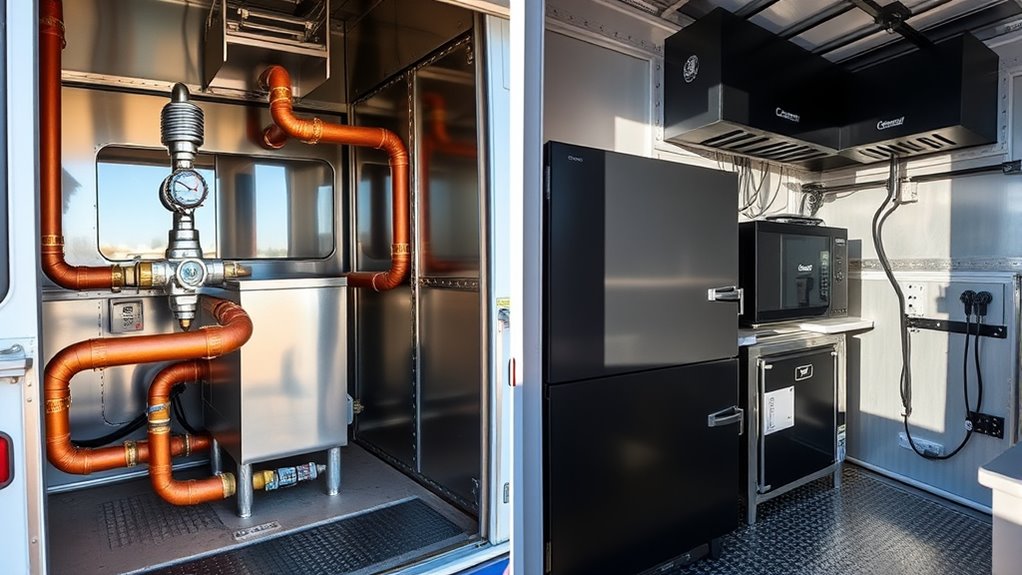
When installing appliances in your food truck, you need to consider space requirements to ensure everything fits comfortably. Safety protocols are essential to prevent accidents, especially with gas connections. Additionally, you’ll need to evaluate utility connections to determine if your truck can support the necessary power or gas supply safely and efficiently. Proper installation also involves verifying that appliances are compatible with the available gas and electrical systems to avoid any hazards. Incorporating risk mitigation strategies can further enhance safety during setup. Consulting with professionals can help ensure that all installation standards are met for both safety and compliance. Ensuring that all components are appropriately ventilated can prevent dangerous buildup of fumes or heat during operation. Moreover, understanding the mind-body connection underlying somatic therapy can improve safety practices by promoting awareness and alertness during installation procedures.
Space Requirements
Choosing between gas and electric appliances considerably impacts your food truck’s layout, as each type has distinct space requirements for installation and setup. Gas appliances often need extra room for ventilation needs, ensuring proper airflow and safety. You’ll also need dedicated storage considerations for tanks and regulators, which take up additional space. Electric appliances, on the other hand, usually require less room overall, since they don’t need ventilation or gas connections. However, you might need space for heavy-duty power supplies or batteries. Keep in mind that:
- Gas appliances demand ventilation hoods and exhaust systems
- Storage for propane tanks or gas lines
- Adequate clearance for safe operation
- Power supply setup for electric units
- Incorporating AI-driven design tools can assist in optimizing your kitchen layout and workflow, ensuring efficient use of space and safety measures. Additionally, understanding space requirements is essential for complying with safety regulations and ensuring smooth operation. Proper planning for appliance placement can help maximize your available space and improve overall efficiency. Balancing these factors will help optimize your kitchen layout and workflow.
Safety Protocols
Proper safety protocols during installation and setup are essential to prevent accidents and guarantee the reliable operation of your food truck’s appliances. Fire hazards are a major concern, so ensure all connections are secure and follow manufacturer instructions carefully. Proper ventilation reduces the risk of buildup and potential fires. Keep emergency procedures clearly posted and accessible, so you can respond swiftly if needed. Use appropriate protective gear during installation, and double-check electrical or gas connections for leaks or faults. Regular inspections and testing help identify potential hazards early. Remember, neglecting safety protocols can lead to dangerous situations, equipment damage, or costly downtime. Incorporating a methodical approach ensures systematic safety checks throughout the setup process. Additionally, understanding appliance safety standards can help you adhere to best practices and legal requirements. Staying informed about fire safety measures is crucial for preventing and responding to emergencies effectively. Prioritize safety during setup to protect yourself, your staff, and your customers, and to maintain a smooth, reliable operation. Maintaining Proper ventilation during installation is also critical to prevent the buildup of dangerous gases and ensure a safe working environment. Implementing safety training for staff further enhances overall safety awareness and preparedness.
Utility Connections
Installing and setting up utility connections correctly is essential to guarantee your food truck operates safely and efficiently. Properly connecting your fuel supply and utility lines ensures reliable operation and prevents hazards. When working with gas appliances, you’ll need secure, code-compliant connections to your fuel supply to avoid leaks. For electric setups, ensure your electrical connections are properly grounded and meet local standards. Keep these considerations in mind:
- Verify the fuel supply line is rated for your appliances’ capacity
- Use approved connectors and fittings for safety
- Properly route utility connections to prevent damage or interference
- Schedule professional inspections to confirm correct installation
- Regular inspections of heated and electrical components are recommended to maintain safety and functionality for safe use. Additionally, staying informed about automated safety systems can help prevent potential hazards before they occur. Incorporating proper grounding techniques is also crucial to ensure electrical safety and prevent shocks or fires. Remaining aware of code compliance ensures your setup adheres to local regulations, reducing legal and safety risks. Ensuring your connections are compatible with the specific Kia Tuning modifications can further enhance safety and performance. Prioritizing correct utility connections helps you avoid costly repairs and safety issues down the line.
Energy Efficiency and Operating Costs
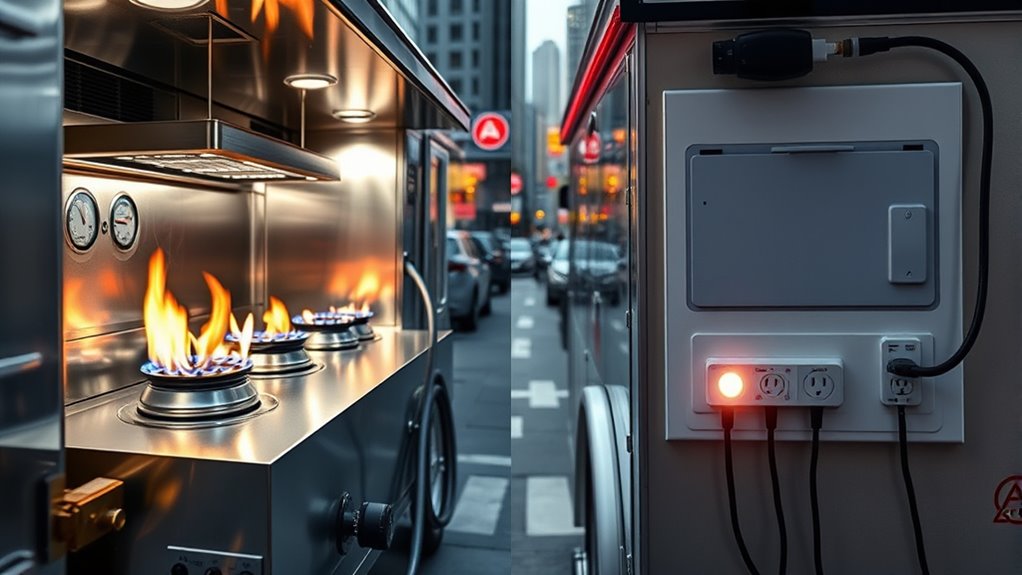
Electric appliances often have lower energy consumption than gas counterparts, which can lead to significant savings over time. Reduced energy use means lower operating expenses and improved profit margins. While initial costs may vary, electric systems tend to be more efficient, especially with modern technology. To better understand, consider this comparison:
| Aspect | Gas Appliances | Electric Appliances |
|---|---|---|
| Energy Consumption | Higher, due to inefficient combustion | Lower, thanks to high efficiency motors |
| Operating Expenses | Potentially higher, with fuel costs | Generally lower, with cheaper electricity |
| Maintenance | More frequent, due to burners and vents | Less, mainly electrical component checks |
Choosing electric can cut long-term costs, boosting your food truck’s profitability. Additionally, electric systems can benefit from recent advancements in energy-efficient technology, further reducing operational costs. This shift not only enhances cost savings but also supports environmental sustainability by reducing emissions.
Performance and Cooking Capabilities
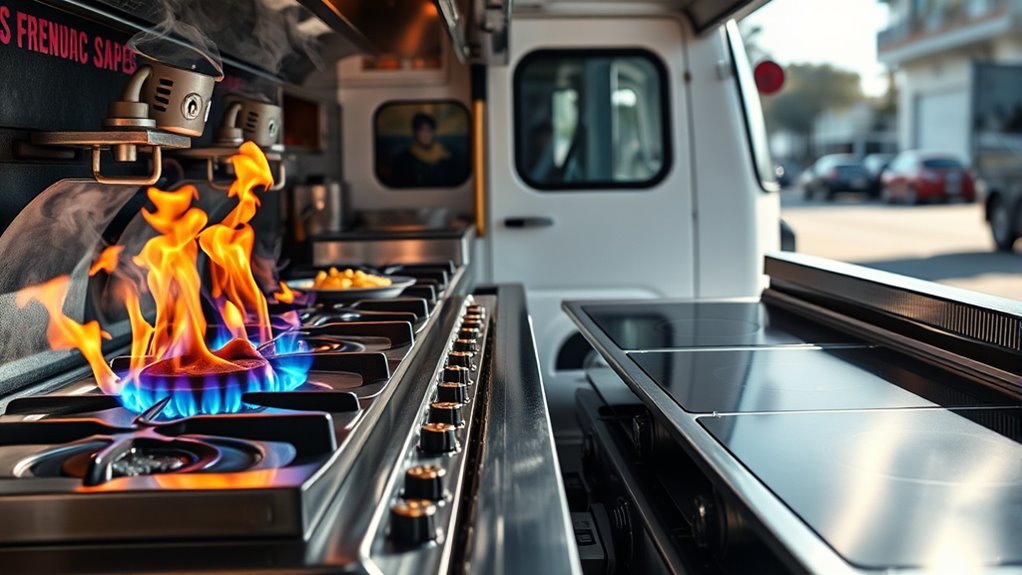
When it comes to performance, you’ll want appliances that heat quickly and deliver enough power for busy service. Precise temperature control helps you cook consistently, while versatility allows you to handle a variety of dishes. Understanding these factors can help you choose the best setup for your food truck’s needs.
Heating Speed and Power
Gas appliances generally heat up faster and deliver more immediate, high-powered cooking performance compared to electric models. This means you can start cooking quickly, saving time during busy hours. Gas burners typically have higher heat output, allowing for faster searing and boiling. They also tend to be more fuel-efficient for short, intense cooking tasks. However, they can produce higher noise levels, which might be distracting in a busy environment. Gas units often require more maintenance due to their combustion process. Electric appliances, while slower to heat, offer steady, consistent performance with less noise and simpler operation. They usually consume less energy over long periods, but may struggle with rapid temperature changes. Consider your menu needs and operational priorities to choose the best option for your food truck.
Temperature Control Precision
Temperature control precision considerably impacts your ability to execute recipes consistently and achieve desired results. When using gas or electric appliances, maintaining steady temperature consistency is vital, especially during delicate cooking processes. Electric appliances often offer better calibration accuracy, allowing you to set precise temperatures and trust they’ll stay stable. Gas appliances, while responsive, can sometimes experience fluctuations due to variations in flame intensity, making exact temperature control more challenging. If your recipes require tight control—like melting chocolate or simmering sauces—accurate calibration and consistent heat are essential. Ultimately, choosing appliances with superior temperature control helps guarantee your dishes turn out the same every time, elevating your food truck’s performance and customer satisfaction.
Cooking Versatility and Range
Electric appliances generally offer a wider range of cooking options and more consistent performance across different tasks. This means you can easily switch between sautéing, simmering, baking, or frying without worrying about uneven heat. Their precise temperature controls enhance your cooking versatility, allowing you to fine-tune settings for different dishes. When considering range options, electric units often provide smoother, more responsive burners or cooktops that adapt quickly to your needs.
- Multiple heat zones for diverse cooking styles
- Precise temperature adjustments for delicate dishes
- Faster response times for changing heat levels
- Compatibility with specialized cookware for varied recipes
Safety and Maintenance Requirements
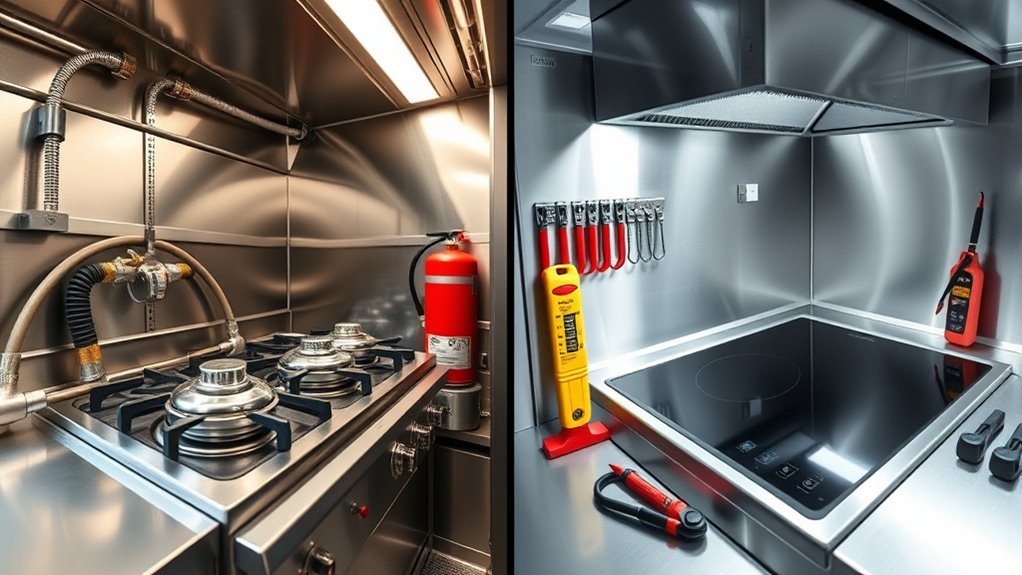
While choosing between gas and electric appliances, understanding safety and maintenance requirements is essential for smooth operations. Gas appliances pose fire hazards if not properly installed or maintained, so regular inspections are vital. You should follow strict maintenance schedules to prevent leaks, ensure proper ventilation, and avoid accidents. Electric appliances generally have fewer safety concerns but still require routine checks for electrical faults or damaged cords. Both types need cleaning to prevent grease buildup, which can increase fire risks. Keep fire extinguishers nearby and train staff on safety procedures. Regularly scheduled maintenance minimizes downtime and extends appliance lifespan. Staying proactive with safety and maintenance helps you prevent costly repairs and ensures a safe environment for your staff and customers.
Space and Portability Factors
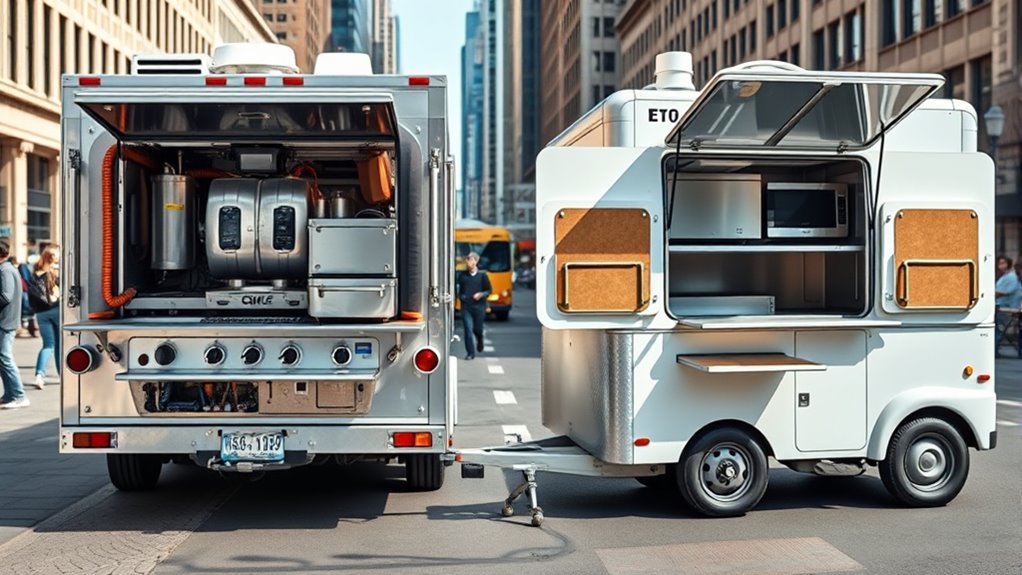
When selecting appliances for your food truck, space and portability are crucial considerations that can influence your overall setup and workflow. You need equipment with a portable design that fits comfortably within limited space and allows easy movement. Consider storage considerations to keep your workspace organized and efficient.
Prioritize space-saving, portable appliances to maximize efficiency and workflow in your food truck.
- Opt for compact appliances that maximize available space
- Choose lightweight, portable designs for easy setup and relocation
- Prioritize appliances with built-in storage or stacking options
- Assess your truck’s layout to ensure seamless workflow and accessibility
Balancing size and functionality helps you create a streamlined kitchen. Properly selected appliances prevent clutter and improve efficiency, making your food truck more practical and easier to operate on the go.
Environmental Impact and Sustainability
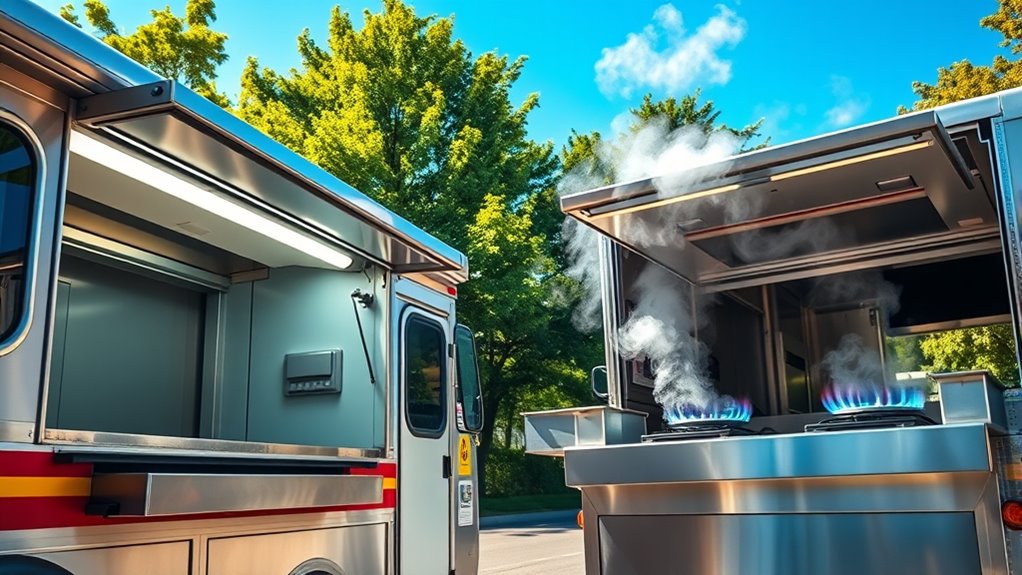
Choosing appliances that fit your food truck’s space and are easy to move is important, but considering their environmental impact is equally essential. Electric appliances often have a lower carbon footprint, especially if powered by renewable energy sources like solar or wind. They produce fewer emissions during operation, helping reduce your overall environmental impact. Gas appliances, on the other hand, rely on fossil fuels, which contribute more to greenhouse gases and air pollution. By opting for electric options, you support sustainability and help combat climate change. Additionally, many electric appliances are designed to be energy-efficient, further decreasing their environmental footprint. Making eco-conscious choices in your food truck setup not only benefits the planet but can also appeal to environmentally-minded customers.
Regulatory and Licensing Requirements
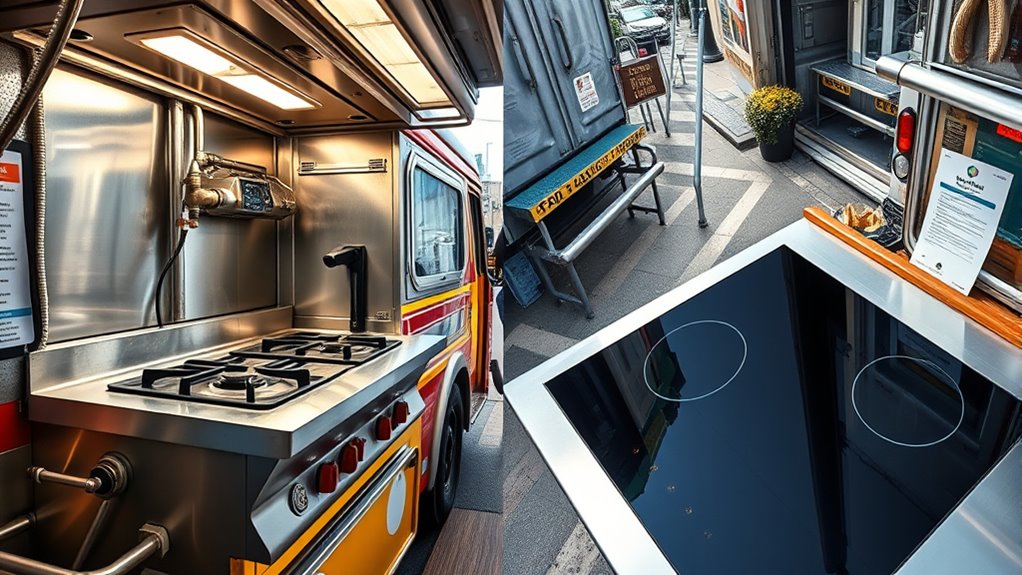
Guiding the regulatory and licensing requirements for food truck appliances is essential to guarantee your setup adheres to local laws. You’ll need to navigate fire code compliance, ensuring your appliances meet safety standards. Licensing procedures vary by location but often require permits for gas or electric systems, depending on your equipment. Understanding these rules helps prevent fines or shutdowns.
- Obtain necessary permits for gas or electric appliances
- Ensure fire code compliance with proper installation and safety features
- Complete health department inspections related to your setup
- Adhere to local licensing procedures for food trucks and equipment
Staying informed about these requirements ensures your food truck operates smoothly and legally, avoiding costly setbacks and ensuring safety for you and your customers.
Making the Right Choice for Your Food Truck
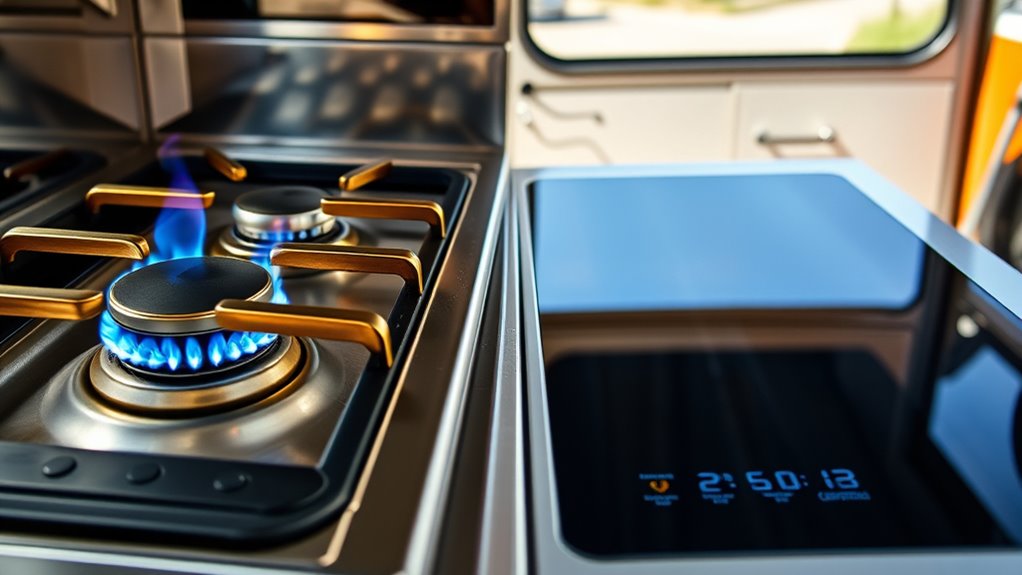
Deciding between gas and electric appliances for your food truck depends on several practical factors, including your menu, available space, budget, and local regulations. Your menu influences appliance choice; for example, specific cooking styles may require gas burners or electric induction. Consider how appliances impact menu customization—gas stoves often offer more control, enabling diverse dishes. Space constraints matter too; electric units tend to be more compact, fitting smaller trucks easily. Budget is another key factor: upfront costs and ongoing energy expenses vary. Additionally, think about branding opportunities—electric appliances can be integrated seamlessly into your truck’s design, creating a sleek, modern look. Ultimately, choosing the right appliances enhances your menu flexibility, brand image, and operational efficiency, helping your food truck stand out and succeed.
Frequently Asked Questions
How Do Gas and Electric Appliances Affect Customer Perception?
You might notice that your choice of appliances impacts customer perception considerably. Gas appliances often convey a sense of reliability and traditional quality, boosting customer trust, especially when paired with a visually appealing setup. Electric appliances can seem modern and clean, enhancing visual appeal. Ultimately, your decision influences how customers perceive your food truck’s professionalism and hygiene, shaping their overall experience and trust in your brand.
What Are the Typical Lifespan Differences Between Gas and Electric Equipment?
When considering durability comparisons, gas appliances often have a longer lifespan, typically lasting 10-15 years with proper maintenance. Electric equipment usually needs replacements sooner, around 8-12 years, due to wear and technological updates. You should factor in replacement timelines, as gas systems might require fewer replacements over time, while electric ones could need upgrades sooner. This difference impacts your maintenance costs and long-term investment planning.
Are There Any Government Incentives for Choosing Energy-Efficient Appliances?
Think of government incentives as a helpful wind beneath your wings. You can often find government rebates and energy grants that make switching to energy-efficient appliances more affordable. These programs are designed to light your path toward sustainability, offering financial relief and encouraging greener choices. By tapping into these opportunities, you not only save money but also contribute to a cleaner environment—making your food truck journey both eco-friendly and economically smart.
How Do Maintenance Costs Compare Over the Appliance Lifespan?
You’ll find that maintenance costs impact your overall cost efficiency and vary by appliance type. Electric appliances usually have lower repair complexity, which can save you money over time, but their parts might be pricier to replace. Gas appliances, on the other hand, often require more frequent maintenance due to wear and tear, potentially increasing repair costs. Consider these factors to choose the most cost-effective option for your food truck.
Can Appliances Switch Between Gas and Electric Power Sources Easily?
Switching appliances between gas and electric power sources isn’t typically easy. You’ll find that fuel compatibility and installation complexity play big roles here. Many appliances are designed specifically for one power source, so converting them often requires significant modifications, which can be costly and complicated. If you want flexibility, look for models that are either dual-fuel compatible or easy to retrofit, but know that most standard appliances aren’t built for quick switches.
Conclusion
Choosing between gas and electric appliances is like selecting the heart of your food truck’s soul. Gas fuels your passion with power and tradition, while electric symbolizes innovation and clarity. Consider your needs carefully—what kind of flame ignites your culinary dreams? Whichever path you take, remember, it’s your unique journey that will make your food truck truly shine. Trust your instinct, and let your choice be the guiding star on your flavorful adventure.
